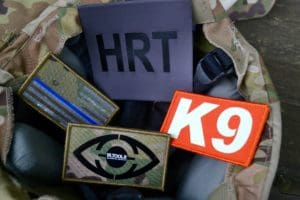We are often asked, “How far away can I see a thermal ID marker ?”
While this is actually a complicated question, let me breakdown it for you to help you understand.
First, keep in mind that thermal imagers DO NOT amplify energy while night vision goggles DO amplify energy. Because of this amplification a small night vision combat ID marker will appear larger than it really is.
Second, there are numerous major factors which affect detection in a thermal imager.
- Distance: How far away is the target
- IFOV: Basically the optics
- Resolution: How many pixels in the thermal imager’s sensor
- Display: If a human is looking at a screen, that resolution and their eyes effect detection.
- Object size
- Emissivity of the marker: The quality of the marker
You can access a SPREADSHEET that allows you understand how the first four items relate.
Steps to Determine Distance Calculations:
- Input the object size
- Input the IFOV and resolution from your thermal imager’s user’s manual.
- Determine how many pixels on the screen will need to be covered for the human to detect the combat ID marker
- The result will be the distance at which you can detect the object.
Steps to Determine Size Calculations:
- Input the distance to the object
- Input the IFOV and resolution from your thermal imager’s user’s manual.
- Determine how many pixels on the screen will need to be covered for the human to detect the combat ID marker
- The result will be the size of combat ID marker you could detect.
Finally, detection and identification are different. You can detect something without being able to identify it. In order to differentiate in the spreadsheet, change the pixels requirement. Generally, the pixels to detect will be less than the pixels required to identify.
If you have questions, contact us and we will help.
The Author:
 Tom established IR.Tools™ in 2006, working out of his home for several years before growing into an official office space in 2012. As a veteran and engineer, Tom was led down a path to manufacturer quality infrared markers and insignia for soldiers and military equipment. “My passion for the military, engineering and business leadership all came together in a perfect blend at the perfect time.” An innovator who is always moving forward to stay ahead of the industry, Tom has 15 awarded patents, and 10 patents pending. The Cattis (Calibration Targets for Thermal Weapon Sights) is one of his “babies”, a quick and easy solution for sighting weapons. Tom received his BS and MS in Mechanical Engineering from the University of Maryland, College Park and his MBA from Regents University.
Tom established IR.Tools™ in 2006, working out of his home for several years before growing into an official office space in 2012. As a veteran and engineer, Tom was led down a path to manufacturer quality infrared markers and insignia for soldiers and military equipment. “My passion for the military, engineering and business leadership all came together in a perfect blend at the perfect time.” An innovator who is always moving forward to stay ahead of the industry, Tom has 15 awarded patents, and 10 patents pending. The Cattis (Calibration Targets for Thermal Weapon Sights) is one of his “babies”, a quick and easy solution for sighting weapons. Tom received his BS and MS in Mechanical Engineering from the University of Maryland, College Park and his MBA from Regents University.


